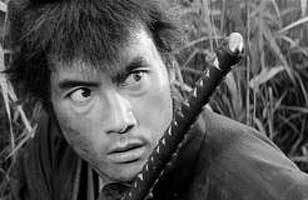Category: The Criterion Collection
My neverending quest to watch all of the Criterion Collection films.
A part of this viewing list: Criterion Collection Spine #311: Hideo Gosha’s Sword of the Beast.
It just happens to be coincidence that I was reading the Hagakure when this movie came in on my hold list at the library.
Naoshige once said, “The Bushido signifies desperate death. Several tens of sane samurais could not kill a single samurai [who burns with this mad death].”
Sane men of calmly composed mind cannot accomplish a great enterprise. You have only to get wildly crazy to the point of death. The moment discretion and consideration mingle with your Bushido, you will surely hesitate and lag behind your enterprise.
To the Bushido, loyalty and filial duty will naturally follow from your madness. Because in this desperate death, both of these qualities dwell in your actions.
If ever there was a samurai who embodies the desperate death of Bushido, the character of Gennosuke in Sword of the Beast is that man. His tale takes place as the Tokugawa shogunate was dwindling, on the cusp of the Meiji Restoration [when the position of samurai was abolished] and soon after Commodore Perry’s ships ended Japan’s long self-imposed cultural isolation. Now that you’ve got a bit of historical context and a bit of the cultural philosophy that drives the actions of the characters in the film, it becomes much more than a hack-and-slash samurai film.

The recurrent theme of human bestiality [not that kind, sicko but I bet that ups my search referrals] is nearly constant, while Gennosuke might behave as a beast at one moment, a breath later he is an honorable samurai. At other points throughout the film other characters behave in similar manners. Jurota, the gold seeker, refuses to save his wife when she falls into the hands of bandit-prospectors; opting instead to remain loyal to his clan. The same prospectors later rape another woman on the mountain and when Jurota’s clan finally shows up, they are bent on killing everyone on the mountain, including Jurota and his wife.
The characters believe that gold will elevate them, but instead it is what causes their bestial behavior. Gennosuke is actually convinced that he is turning into a wolf. Essentially what we get is a distorted form of Bushido that deemphasizes the clan-loyalty in favor of a more Western individual loyalty. After Gennosuke’s betrayal by his own clan, he rapidly adapts this warrior code throughout his ronin and by the end of the film has managed a makeshift balance between his new path and his old Bushido. His failed ambition is mirrored in Jurota’s efforts, and Jurota’s presence on the mountain acts as the catalyst to precipitate Gennosuke’s internal redemption.
The use of flashback does strange things to the continuity, because the first few aren’t signaled very well. Eventually they turn a bit more standard trick and I wonder if this was another deliberate correlation between beast and man, since the ambiguous sequences come deep in the beast phase of Gennosuke’s story. His adapted Bushido would appear very modern to post-WWII Japanese, and Gennosuke’s facility at incorporating it into his life mirrors Japan’s similar facility which allowed them to regroup as an economic power so quickly after their surrender.
I can’t believe I’ve not talked about the fencing yet! It is most excellent, very raw, at times graceful and at times clumsy, necessities depending on terrain and number of opponents. Gennosuke is pretty much a master of the one-stroke kill, and while the deaths are often hammy, I wanted to see more sweet slicing action.
• Criterion Essay by Chris D.
• Criterion Essay by Patrick Macias
• French review [in French, duh] with screen captures.